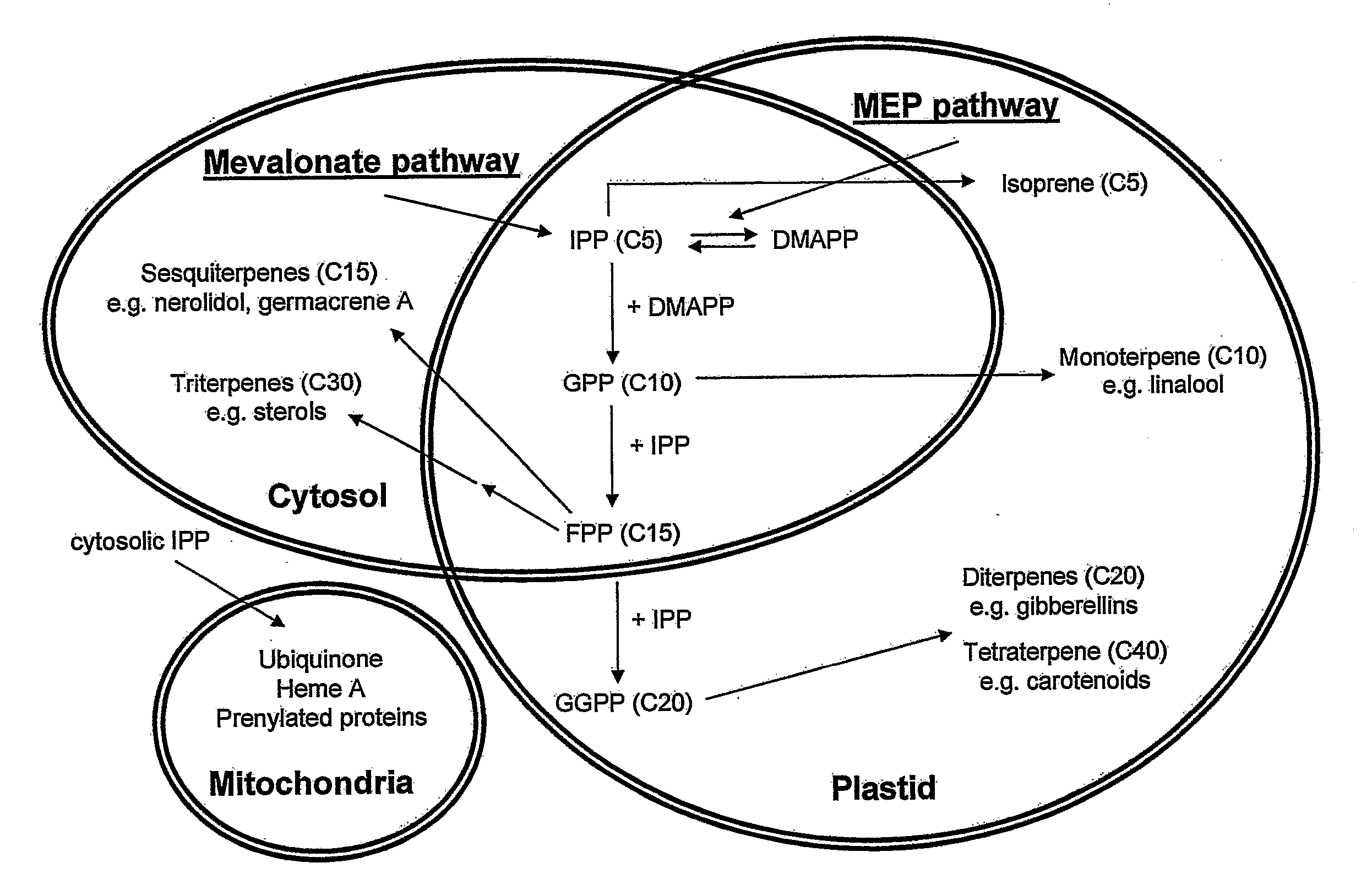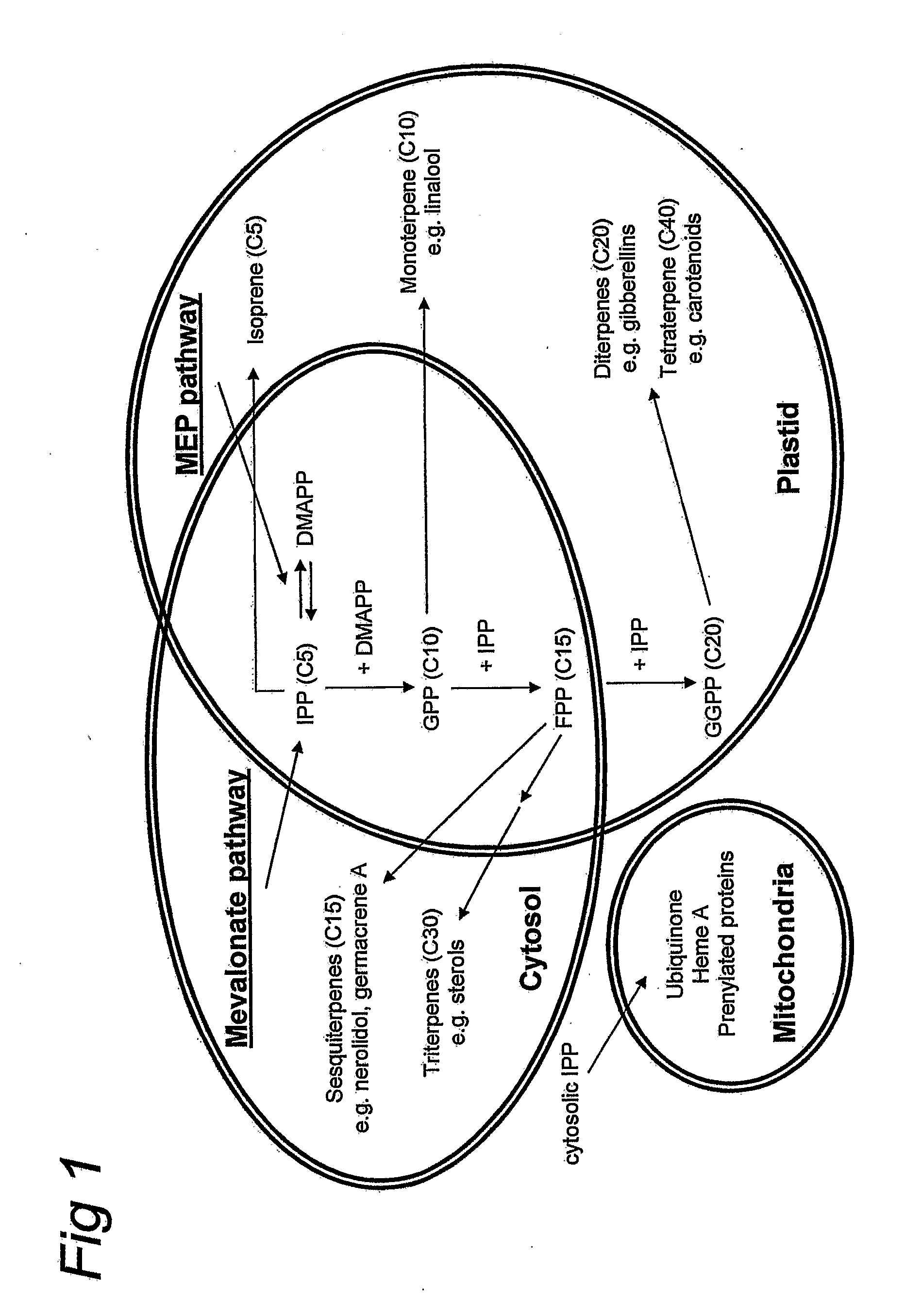Terpene hydroxylation
a terpene hydroxylation and hydroxylation technology, applied in the field of cytochrome p450 monooxygenase enzymes, can solve problems such as difficult analysis
- Summary
- Abstract
- Description
- Claims
- Application Information
AI Technical Summary
Benefits of technology
Problems solved by technology
Method used
Image
Examples
example 1
General Material and Methods
1.1 Plant Material
[0232]Greenhouse-grown strawberry varieties and lines of wild species from the Plant Research International (PRI) breeding collection were used. Volatile analysis (FIG. 2A) was conducted using Elsanta as the cultivated variety and PRI accession 92189 as the wild species. For RNA gel-blots, the Elsanta cultivar (FIGS. 3B, 3E and 3F), the PRI accessions H1 and 92189 as wild species (W) and Gorella and Holiday as cultivated forms (CU; in both FIG. 3C and FIG. 3D) were used. PCR on genomic DNA and expression analysis using RT-PCR (FIG. 6) were carried out using CU1 (cv. Sure crop), CU2 (cv. Holiday), CU3 (cv. Senga sengana), CU4 (cv. Gorella), CU5 (cv. Calypso), CU6 (cv. Elsanta), CU7 (PRI accession 75169), and WI1 (PRI accession FA-1), WI2 (PRI accession FA-2), WI3 (PRI accession FA-3), WI4 (Yellow wonder), WI5 (Alexandria), WI6 (PRI accession 92189), and WI7 (PRI accession H2).
1.2 Analysis of Fruit Volatiles
[0233]For the purpose of headspa...
example 2
Isolation and Characterisation of PINH
[0237]By mining an EST sequence collection generated by random sequencing of a cultivated strawberry ripe fruit cDNA library (Aharoni and O'Connell, 2002), five different EST clones were identified which showed homology to cytochrome P450 genes cloned from a vast number of other organisms. Protein sequence alignment to published cytochrome P450s showed that, of these five, the D59 clone is related to the CYP71 family. This family of cytochrome P450 proteins has previously been shown to be associated with monoterpenes metabolism (Hallahan et al., 1994, Bioch. Biophys. Acta 1, 94-100; Lupien et al., 1999, Arch Bioch Biophys 368: 181-192; Bertea et al, 2001, Arch Bioch Biophys 390: 279-286).
[0238]Detailed gene expression analysis using the five different fragments as probes for RNA gel-blot hybridizations revealed that clone D59 showed increased expression in the ripe red strawberry fruit, but was also expressed, to even higher levels, in roots. Th...
example 3
Substrate Specificity of PINH
[0246]PINH catalytic activity was also tested with a range of other substrates with similar structure. Despite the reported high substrate specificity, a range of other substrates were hydroxylated by PINH. For example, limonene that has an allylic C7, analogous to the α-pinene C10, is efficiently hydroxylated to perilla alcohol (FIG. 3D, FIG. 4). Other substrates that were hydroxylated at the same position were α-phellandrene, α-terpinolene and α-terpinene (FIG. 3 F,H,J; FIG. 4). In addition, the α-phellandrene, α-terpinene and limonene substrates used contained a trace impurity of p-cymene which was also hydroxylated at C7 yielding 4-(1-methylethyl)-benzenemethanol (p-cymen-7-ol) (FIG. 4). In addition, despite the reported high regio-selectivity of cytochrome P450 enzymes also some hydroxylation occurred in different regions. For limonene this second product peak could be identified as limonen-10-ol and for α-terpinolene also two product peaks were vis...
PUM
| Property | Measurement | Unit |
|---|---|---|
| Tm | aaaaa | aaaaa |
| temperature | aaaaa | aaaaa |
| pH | aaaaa | aaaaa |
Abstract
Description
Claims
Application Information
 Login to View More
Login to View More - R&D
- Intellectual Property
- Life Sciences
- Materials
- Tech Scout
- Unparalleled Data Quality
- Higher Quality Content
- 60% Fewer Hallucinations
Browse by: Latest US Patents, China's latest patents, Technical Efficacy Thesaurus, Application Domain, Technology Topic, Popular Technical Reports.
© 2025 PatSnap. All rights reserved.Legal|Privacy policy|Modern Slavery Act Transparency Statement|Sitemap|About US| Contact US: help@patsnap.com



